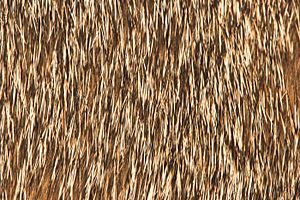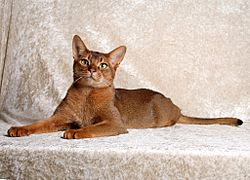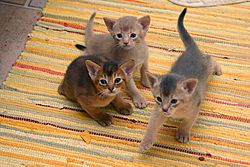Abyssinian cat facts for kids
Quick facts for kids Abyssinian |
|
|---|---|

A male ruddy Abyssinian
|
|
| Origin | Ethiopia |
| Breed standards | |
| CFA | standard |
| FIFe | standard |
| TICA | standard |
| ACF | standard |
| CCA-AFC | standard |
| Domestic cat (Felis catus) | |
The Abyssinian is a special type of breed of domestic short-haired cat. It has a unique "ticked" coat, which means each hair has different color bands. This makes their fur look really interesting! People often call them "Abys" for short. This breed is named after Abyssinia (which is now Ethiopia), where many believe they first came from.
Some experts think Abyssinians are one of the oldest cat breeds. Ancient mummified cats found in Egyptian tombs look a lot like today's Abyssinians. Even though they weren't always super famous, Abyssinians are now one of the top five most popular cat breeds around the world!
Abyssinians look very graceful and sleek, almost like human fashion models. They are known for being active and curious. They often follow their owners around and love to play. People even call them the "Clowns of the Cat Kingdom" because they are so playful! They also have some dog-like qualities, like being very loving and wanting to interact with people a lot.
Contents
History of the Abyssinian Cat
The Abyssinian cat we know today was developed in Great Britain. It is thought that British soldiers brought kittens home from North Africa in the 1800s. They bought these kittens from local traders.
Discover the Abyssinian's Look and Personality
What Does an Abyssinian Look Like?
The Abyssinian is a slender, medium-sized cat with fine bones. Their head is shaped like a wedge, with a gentle slope at the muzzle. Their nose and chin should form a straight line when you look at them from the side. They have alert, fairly large, pointed ears.
Their eyes are shaped like almonds and can be gold, green, hazel, or copper. The color depends on their fur. Their legs are long and fit their graceful body. They have small, oval paws. Their tail is also long and gets thinner towards the end.
Abyssinian Coat and Colors
Abyssinian kittens are born with dark coats. Their fur gradually gets lighter as they grow up, usually over several months. An adult Abyssinian's coat should not be too short. It should feel fine, thick, and silky to the touch.
The "ticked" or agouti effect is what makes this breed special. This is a type of tabby pattern. The ticking should be even all over their body. However, the ridge of their spine, tail, back of their hind legs, and paw pads are always darker. Each hair has a light base with three or four bands of color. These bands get darker towards the tip of the hair.
The base color of the fur should be very clear. Too much grey mixed in is not ideal. It's common for them to have a little white on their chin, but it should be very little. You can often see the typical M-shaped tabby marking on their forehead.
The original color for this breed is a warm, deep reddish-brown with black ticking. This color is called "ruddy" in most places. Another color is sorrel, also known as cinnamon or red. This is a lighter coppery color with chocolate brown ticking. It's a unique change from the original pattern.
Other colors have been added by breeding Abyssinians with other cats like the Burmese. These include blue (on a warm beige base) and fawn (on a soft, creamy peach base). Less common colors like chocolate and lilac are recognized by some cat clubs, but not all. The Silver Abyssinian is also recognized in the UK. This cat has a pure silvery white base coat with black, blue, cream, or sorrel ticking.
The special ticked coat of the Abyssinian comes from a dominant gene called Ta. The first cat to have its entire genetic map published was an Abyssinian named Cinnamon.
Abyssinian Personality and Temperament
Abyssinians are a popular breed because they are very smart and have fun, outgoing personalities. They are known for being playful and a bit stubborn. They might get sad if they don't have enough activity or attention from their owners.
Experts have noted that Abyssinians form a strong bond with their owners, similar to a dog. This means they depend more on human interaction. Other cat breeds might just accept human company for comfort.
Because they love to play with their owners and are so curious and smart, Abyssinians are often called the "Clowns of the Cat Kingdom." They are active and outgoing, but they tend to be quiet cats. Their sounds are soft, like chirps, and don't sound like a typical "meow." They are very loving and friendly towards people.
Abyssinian Cat Health
Abyssinians can sometimes get gingivitis, which is a gum problem. This can lead to a more serious gum disease called periodontitis. They can also have a kidney problem called familial renal amyloidosis. This is a genetic condition.
Abyssinians used to have serious problems with blindness. This was caused by a genetic eye disease called retinal degeneration. However, thanks to genetic tests, the number of affected cats has greatly decreased. For example, in Sweden, the rate dropped from 45% to less than 4% by 2008. With these tests, breeders can help reduce this disease in all Abyssinian populations.
Related Cat Breeds
- Somali cats are very similar to Abyssinians. They have the same genes, but Somalis have long hair because of a specific gene.
- Ocicats were created by accident. They came from breeding Abyssinians with Siamese cats.
See also
 In Spanish: Abisinio (gato) para niños
In Spanish: Abisinio (gato) para niños





